

Heart. Parts of the Cell. Phenotype-babies.pdf. Baby_lab. Introduction To Heredity. The 2004 publication Investigating Safety: A Guide for High School Teachers by Texley et al. has raised an alarm in the teaching community about the usefulness and safety of PTC taste testing.
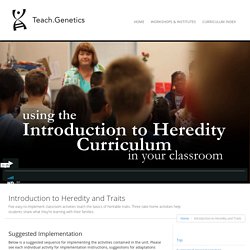
This has led to PTC being banned from many schools and districts - we believe unnecessarily. Yes, PTC is toxic. In rats, the most sensitive animals tested, the oral LD50 of PTC (the amount that killed 50% of test animals) is 3 mg/kg. However, PTC is so intensely bitter that tasters can detect it in miniscule quantities. ExploringGenetics.pdf. How to Extract DNA from Anything Living. First, you need to find something that contains DNA.
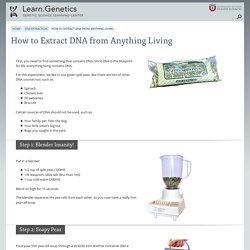
Since DNA is the blueprint for life, everything living contains DNA. For this experiment, we like to use green split peas. But there are lots of other DNA sources too, such as: Spinach Chicken liver Strawberries Broccoli Certain sources of DNA should not be used, such as: Your family pet, Fido the dog Your little sister's big toe Bugs you caught in the yard. Cell Tutorial- Anatomy - Health and Science.
Lesson Plan: Characteristics of Living Things. Review with students these six easily observable characteristics of living things: movement (which may occur internally, or even at the cellular level) growth and development response to stimuli reproduction use of energy cellular structure The student data table includes links to all the information and videos necessary to complete this activity.

Entire class—projecting the videos Click on each link in the "Category" column on the data table. Students can take turns reading the introductions aloud. Show the videos and have the students complete the data table for each organism. Defining "life" is a very difficult task, and scientists don’t all agree on a common list of the characteristics of life. Characteristics of Living Things All organisms use energy (metabolism). Thanks to Bonnie Daley, seventh-grade life sciences teacher in the San Francisco Unified School District, who developed a prototype of this activity. Is It Alive? Alive sorting cards. 1. Is it alive? What does it mean to be alive?
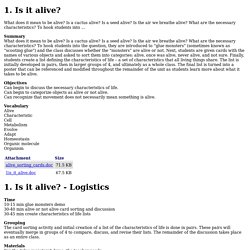
Is a cactus alive? Is a seed alive? Is the air we breathe alive? What are the necessary characteristics? To hook students into ... SummaryWhat does it mean to be alive? ObjectivesCan begin to discuss the necessary characteristics of life.Can begin to categorize objects as alive or not alive.Can recognize that movement does not necessarily mean something is alive. Classroom_foodweb_tifs.pdf. Mount St. Helens Ecosytem. Ecological Succession: Change is Good - Crash Course Ecology #6. Biomes at Missouri Botanical Gardens Worksheet. Name:_______________________________________ Date:_________ Objective: Understand the plants, animals and climate that characterize each biome of the world.
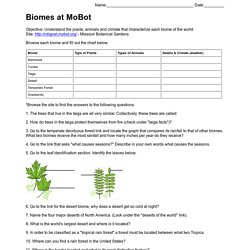
Site: - Missouri Botanical Gardens Browse each biome and fill out the chart below. *Browse the site to find the answers to the following questions. 04 Biomes - Google Slides. Desert Food Chain Video (DesertUSA) Endangered Ecosystems: Build a Food Web. Food Chain - Kid's Corner. The Food Chain Every living thing needs energy in order to live.
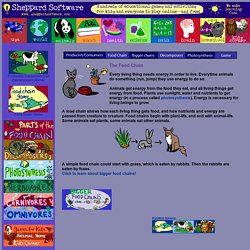
Everytime animals do something (run, jump) they use energy to do so. Animals get energy from the food they eat, and all living things get energy from food. Plants use sunlight, water and nutrients to get energy (in a process called photosynthesis). Watch this haunting look at Chernobyl, as seen by drones. 7.10C - Ecological Succession - Pasadena Independent Schoo... Abiotic vs. Biotic. Ecology. Ecology is a large theme, and often not given full coverage in a biology class due to time constraints.
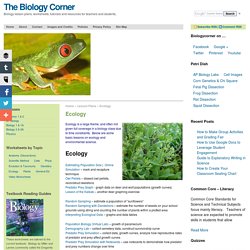
Below are some basic lessons on ecology and environmental science. Ecology Estimating Population Size | Online Simulation – mark and recapture technique Owl Pellets – dissect owl pellets, reconstruct skeletons Predator Prey Graph - graph data on deer and wolf populations (growth curves)Lesson of the Kaibab – another deer graphing exercise Random Sampling – estimate a population of “sunflowers”Random Sampling with Dandelions – estimate the number of weeds on your school grounds using string and counting the number of plants within a plotted areaInterpreting Ecological Data – graphs and data tables Examine an Ecosystem – observation of jar/pond waterExamine Succession – graphic shows how species are replaced as a pond dries up. Build an Ecosystem – use bags, water BTB, oxygen dataFood Web Label - web lesson, research site, fill out table and answer questionsBiome Map - color N.
Biome Map. Name:___________________________________________ Questions 1.
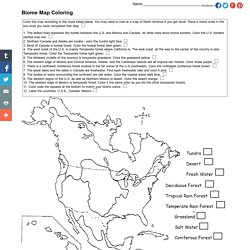
Name the 3 main biomes of the United States (land only).__________________________________________________ 2. Estimating Population Size. Names__________________________________ __________________________________________ Objective: You will be expected to estimate the size of a sample population using the mark-recapture technique.

Be able to apply the technique to new population problems and compare the mark and recapture technique to other methods of population estimating. 1. If you were in charge of a team given the responsibility to determine the number of sunfish in Horseshoe Lake, discuss with your partner how would you accomplish this task and describe in detail below. A technique called sampling is sometimes used to estimate population size. Build-A-Prairie, presented by Bell LIVE! Cells Tissue and Organs. eSkeletons.